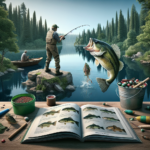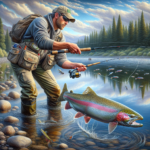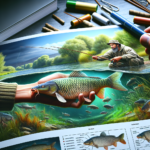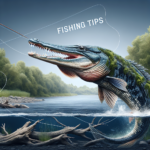Fishing Tips on How to Catch Crappie

Introduction
Crappie, a popular freshwater fish species, is highly sought after by anglers for its delicious taste and the challenge it presents. Known for their elusive nature and schooling behavior, crappie fishing is a favorite pastime for many recreational fishers. This article will provide a comprehensive guide on how to catch crappie, covering everything from their physical characteristics and habitats to the best fishing techniques, gear recommendations, and common mistakes to avoid.
Fish Species Overview
Description
Crappie are part of the sunfish family and are typically characterized by their silvery-green bodies with dark, irregular spots. They have a compressed body shape, making them appear somewhat flat. Crappie can grow up to 10-15 inches in length and weigh between 1-2 pounds, although larger specimens are not uncommon.
Habitat
Crappie prefer freshwater environments and are commonly found in lakes, reservoirs, ponds, and slow-moving rivers. They thrive in areas with abundant vegetation, submerged structures, and clear waters. In North America, crappie are prevalent in the central and eastern regions, with notable populations in states like Minnesota, Wisconsin, and Alabama.
Behavior
Crappie are known for their schooling behavior, often congregating in large numbers around submerged structures such as fallen trees, brush piles, and docks. They are opportunistic feeders, primarily consuming small fish, insects, and crustaceans. Crappie spawn in the spring when water temperatures reach around 60-70°F, making this an ideal time for anglers to target them. They are most active during dawn and dusk, although they can be caught throughout the day under the right conditions.
Challenges
One of the main challenges anglers face when targeting crappie is their tendency to move frequently, making them difficult to locate. Additionally, their light bite can be hard to detect, requiring anglers to have a keen sense of touch and quick reflexes.
Best Time to Catch Crappie
Seasonal Considerations
The best time to catch crappie is during their spawning season in the spring, typically from March to May. During this period, crappie move into shallow waters to lay their eggs, making them more accessible to anglers. Fall is another productive season as crappie feed heavily in preparation for winter.
Time of Day
Crappie are most active during the early morning and late evening hours. Fishing during these times increases the likelihood of encountering feeding schools. However, crappie can also be caught during the day, especially if you target shaded areas or deeper waters where they may be hiding.
Weather Conditions
Ideal weather conditions for crappie fishing include overcast days with calm waters. Cloudy skies reduce light penetration, making crappie more likely to venture into shallower waters. Additionally, stable weather patterns are preferable, as sudden changes can disrupt crappie behavior and make them harder to locate.
Top Fishing Techniques for Crappie
Technique 1: Jigging
Jigging involves using a small, weighted lure (jig) that mimics the movement of prey. This technique is effective for crappie because it allows anglers to present the bait precisely where crappie are hiding. Vertical jigging near submerged structures or along drop-offs can yield excellent results. Using brightly colored jigs can also attract crappie’s attention.
Technique 2: Minnow Fishing
Live minnows are a favorite bait for crappie. Rigging a minnow on a small hook and suspending it under a bobber allows for a natural presentation. This technique works well in both shallow and deep waters. Adjusting the depth of the bait can help locate crappie at different levels in the water column.
Technique 3: Spider Rigging
Spider rigging involves using multiple rods spread out from a boat, each rigged with different baits or lures. This technique covers a wide area and increases the chances of locating crappie schools. It’s particularly effective in open water or when crappie are scattered.
Pro Tips
- Use light tackle to detect subtle bites.
- Experiment with different jig colors and sizes to find what works best.
- Pay attention to water temperature and adjust your fishing depth accordingly.
- Use a fish finder to locate submerged structures and schools of crappie.
Recommended Gear for Catching Crappie
Fishing Rod and Reel
A light to ultralight spinning rod and reel combo is ideal for crappie fishing. A rod length of 6-7 feet provides the sensitivity needed to detect light bites while offering enough leverage to handle larger fish.
Fishing Line
Monofilament line with a strength of 4-8 pounds is recommended for crappie fishing. Monofilament is less visible in the water and provides the stretch needed to prevent line breakage. For clearer waters, fluorocarbon line can be used for its low visibility and abrasion resistance.
Hooks and Baits
Small hooks in sizes 4-8 are suitable for crappie. When using live bait, such as minnows, a size 6 hook is ideal. For artificial baits, consider using soft plastic jigs, tube baits, or small crankbaits. Bright colors like chartreuse, pink, and white are particularly effective.
Additional Gear
- Bobbers: Use slip bobbers to adjust the depth of your bait easily.
- Sinkers: Small split shot sinkers help keep your bait at the desired depth.
- Fish Finder: A fish finder can help locate schools of crappie and underwater structures.
Best Locations to Find Crappie
General Locations
Crappie are commonly found in freshwater lakes, reservoirs, ponds, and slow-moving rivers. They prefer areas with abundant vegetation, submerged structures, and clear waters.
Specific Regions
Some popular regions for crappie fishing include:
- Lake of the Ozarks, Missouri
- Reelfoot Lake, Tennessee
- Weiss Lake, Alabama
- Lake Eufaula, Oklahoma
- Grenada Lake, Mississippi
Common Mistakes to Avoid
Mistake 1: Using Heavy Tackle
Using heavy tackle can make it difficult to detect crappie bites and may result in fewer catches. Opt for light to ultralight gear to improve sensitivity and increase your chances of success.
Mistake 2: Fishing Too Deep or Too Shallow
Crappie can be found at various depths depending on the season and water temperature. Use a fish finder or experiment with different depths to locate where crappie are holding.
Mistake 3: Ignoring Submerged Structures
Crappie often congregate around submerged structures such as fallen trees, brush piles, and docks. Targeting these areas can significantly increase your chances of catching crappie.
Catch and Release Tips
Importance of Conservation
Practicing catch and release helps maintain healthy crappie populations and ensures future generations can enjoy this sport. Ethical fishing practices contribute to the sustainability of the species.
Proper Handling Techniques
- Use wet hands or a wet cloth to handle the fish to avoid removing their protective slime coat.
- Minimize the time the fish is out of the water.
- Use barbless hooks or crimp the barbs to make hook removal easier and less damaging.
- Support the fish’s body when lifting it out of the water to prevent injury.
Legal Considerations
Be aware of local regulations regarding size limits, bag limits, and protected areas. Always check with local authorities or fishing guides to ensure compliance with current laws.
Frequently Asked Questions (FAQs)
What is the best bait for catching crappie?
The best bait for catching crappie includes live minnows, small jigs, and soft plastic baits. The choice of bait can vary depending on the season, water conditions, and local preferences. Brightly colored jigs and tube baits are particularly effective in attracting crappie.
Where is the best place to fish for crappie?
Crappie are commonly found in freshwater lakes, reservoirs, ponds, and slow-moving rivers. Popular fishing spots include areas with abundant vegetation, submerged structures, and clear waters. Notable regions for crappie fishing include Lake of the Ozarks (Missouri), Reelfoot Lake (Tennessee), and Weiss Lake (Alabama).
What time of day is best for catching crappie?
The best time of day to catch crappie is during the early morning and late evening hours when they are most active. However, crappie can also be caught throughout the day, especially in shaded areas or deeper waters.
What type of fishing line should I use for crappie?
Monofilament line with a strength of 4-8 pounds is recommended for crappie fishing. Monofilament is less visible in the water and provides the stretch needed to prevent line breakage. For clearer waters, fluorocarbon line can be used for its low visibility and abrasion resistance.
Do I need a special fishing license to catch crappie?
Fishing license requirements vary by location. It’s essential to check with local authorities or fishing guides to determine if a special license is needed. Additionally, be aware of size limits, bag limits, and any special permits required for crappie fishing.
What is the best technique for catching crappie?
Effective techniques for catching crappie include jigging, minnow fishing, and spider rigging. Jigging involves using a small, weighted lure to mimic prey movements, while minnow fishing uses live bait suspended under a bobber. Spider rigging employs multiple rods to cover a wide area and locate crappie schools.
Are there any specific weather conditions that improve the chances of catching crappie?
Overcast days with calm waters are ideal for crappie fishing. Cloudy skies reduce light penetration, making crappie more likely to venture into shallower waters. Stable weather patterns are also preferable, as sudden changes can disrupt crappie behavior.
Can I catch crappie from the shore, or do I need a boat?
Crappie can be effectively caught from both shore and boat. Shore fishing is productive in areas with accessible submerged structures, such as docks and fallen trees. Boat fishing allows anglers to cover more water and reach deeper or less accessible areas where crappie may be hiding.
How can I improve my chances of landing a big crappie?
To increase your chances of catching larger crappie, use larger baits or lures, target deeper waters, and fish during peak feeding times (early morning and late evening). Additionally, focus on areas with abundant food sources and submerged structures where larger crappie may be hiding.
What should I do if I plan to release crappie after catching them?
If you plan to release crappie, practice ethical catch and release techniques. Handle the fish with wet hands or a wet cloth, minimize the time out of the water, use barbless hooks, and support the fish’s body when lifting it. Ensure compliance with local regulations regarding size limits and protected areas.
Conclusion
Crappie fishing offers a rewarding experience for anglers of all skill levels. By understanding their behavior, using the right techniques and gear, and practicing ethical fishing practices, you can increase your chances of success. Whether you’re fishing from shore or a boat, targeting crappie during their peak activity times and in their preferred habitats will enhance your fishing experience. So grab your gear, head to your favorite fishing spot, and enjoy the thrill of catching crappie!




